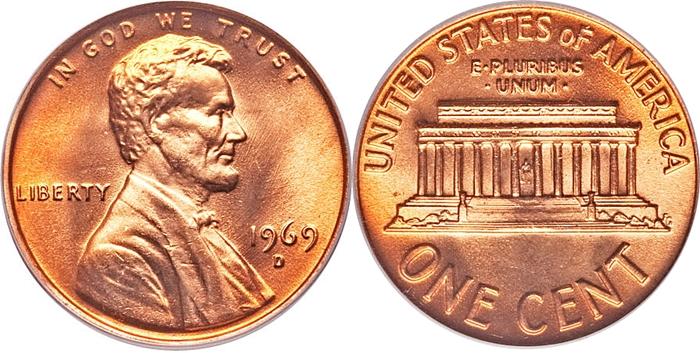

Lincoln Memorial Cents 1959-2008
Lincoln Memorial Collecting Facts
Many don't think of Lincoln Memorial Cents as valuable and this would be true for the bulk of the coins we see every day, but there's many examples of valuable Memorial reverse cents and some can still be found in your pocket change. Furthermore a few can still be found by cherry picking proof sets as well.
The values for Lincoln Memorials resides in their grade for the most part, and the higher the grade the more they're worth, but there's a catch, most Memorials are of low grade, marked up with numerous contact marks, or they're circulated. So high grade examples are rare and difficult to find and even grade. Here you can get a picture view of the higher grades as an example Lincoln Memorial Photograding
The key grade for most Memorial Cents is MS67 (Mint State) and above, but there's a few that have some decent value in MS66, especially the varieties, of which we will talk about later. The focal areas for contact marks is in Lincoln's hair, cheek, and his lower coat area and this is also the focal points for grading.
Obviously the less the contact marks the higher the grade but I warn you that it's very difficult to find Memorials with a small amount of marks, because they are intended for circulation and no care is taken in their handling. You will find that most BU (Brilliant Uncirculated) Memorial Cents will have a large amount of contact marks from hitting against each other. Proofs on the other hand are carefully handled and why they're not worth as much in higher grades than business strike examples.
We know that Memorial Cents are valuable in the higher grades, but there's some that are valuable in most grades and these are varieties like Doubled Dies among a couple other varieties. So I will list them in order for you the collector's benefit: 1960-D/D Small over Large Date, 1969-S DDO, 1970-s Small Date (High 7), 1972 DDO, 1983 DDR (Doubled Die Reverse), 1984 DDO (Ear Doubled), 1992 & 1992-D Close AM, 1995 DDO, 1998 Wide AM in America, 1999 Wide AM, and 2000 Wide AM.
Of course there's many other doubled die varieties that are not listed hear but will bring a premium. Just remember, the higher the grade the more value for most Memorial Cents. One thing about all of these business strike varieties is that all of them can still be found in your pocket change or collections or rolls.
Also there's some proof Memorials that bring a premium as well and can still be found in proof sets that haven't been cherry picked. Here's the most valuable to look for: 1960 Small Date, 1990 No S Mint Mark, 1981-S Clear S, and there's a few more that can bring a premium.
One thing to watch out for is so-called unsearched rolls and collections since there's no guarantee they haven't been searched by someone in the past and the rolls recrimped. Unsearched proof and mint sets can fall into this catagory as well since a proof set's box can resealed with an adhesive. Furthermore, a mint sewn bag can also be altered and opened and resealed, so always be cautious of unsearched coins in general.
Related links: How To Buy Unsearched Rolls And Lots, Unsearched Cent Rolls (Schemes & Scams), Lincoln Memorial Cent Grading Guide, Lincoln Memorial Cent Values
SPECIFICATIONS: 1959-2008
Designer: Victor David Brenner (Obv), Frank Gasparro (Rev) Diameter: 19 millimeters, Metal content: (1959-82) Copper - 95%, Tin and Zinc - 5%, Weight: 48 grains (3.11 grams)
Metal content: (1982-2008) Copper - .992% Zinc, .008% copper plating, Weight: 2.5 grams


CoinHELP!®
Shop ebay for Lincoln Cents
by date and mint
Shop ebay for Lincoln Memorial Cents
by date and mint
1969-S Doubled Die Lincoln Memorial Cent Identification
1972 Doubled Die Lincoln Memorial Cent Identification
When identifying a 1969-S Doubled Die Obverse (DDO) Lincoln Memorial Cent the entire reverse will show split doubled features except the S mint mark. The mint mark was hand punched into the die after the die was created, and when the die was created it was doubled, so the mint mark can't be doubled.
So if you see an example with doubling of the S mint mark then you know it's fake or is a strike doubled coin. Many collectors mistake strike doubled 1969-S Memorials as a doubled die, but strike doubling happens during the strike, a true doubled die happens before the strike. Experience studying doubled dies verses strike doubling is the only way to become an expert and properly identify doubled dies.
Look closely at the images provided and if a coin doesn't look exactly like the coin in the image, as far as the doubled features are concerned, then it's not a true 1969-S DDO.
The identification of a 1972 DDO resides in a small die gouge on the reverse, if it doesn't have this die gouge or the die gouge is too long or doesn't look like the one in the image provided then it's not a true 1972 Doubled Die and might be fake. Although there's other doubled dies for 1972 the one in the image is the most dramatic version, all others don't have as much doubled features and are identified by other die markers.




